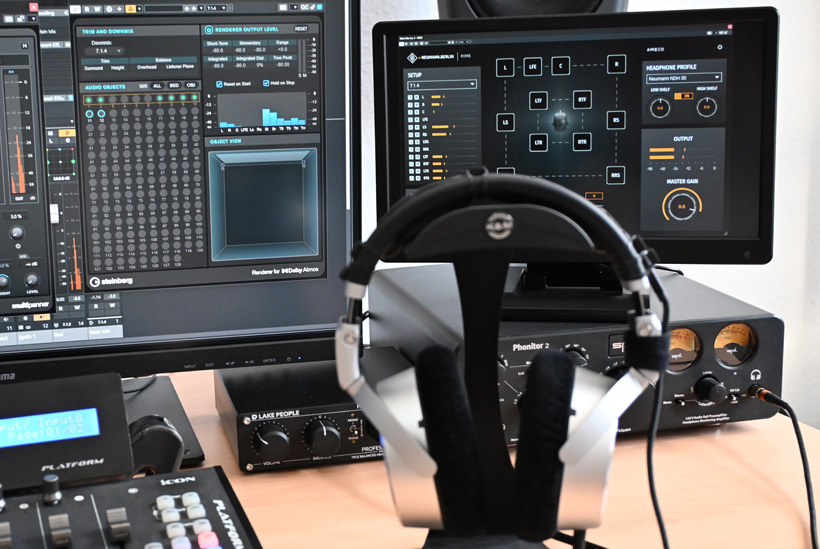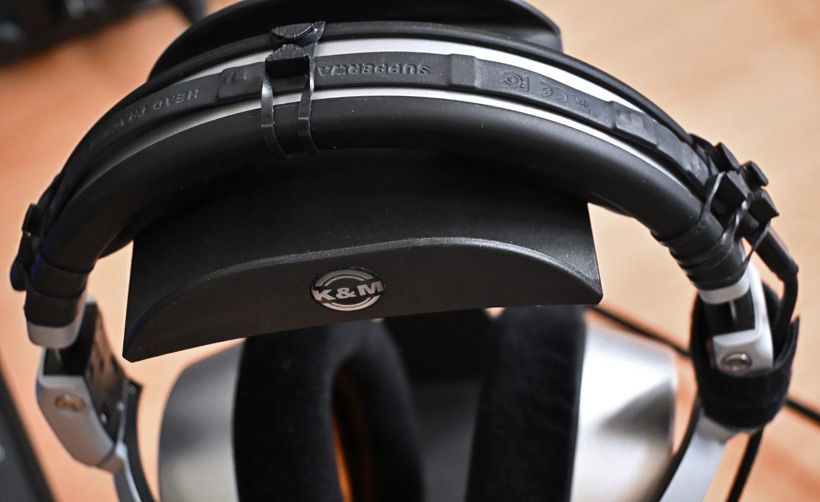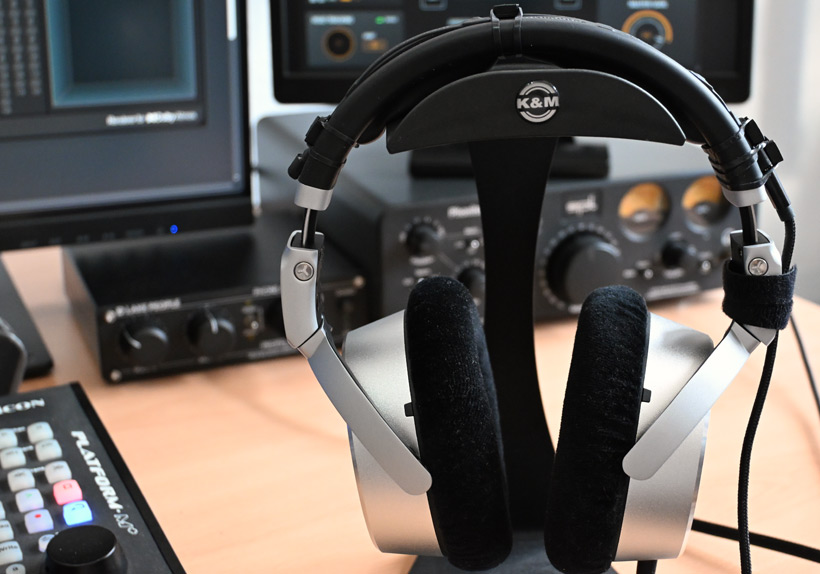Neumann RIME
Binauralization plug-in for Neumann NDH 20 and NDH 30 headphones
Author and photos: Peter Kaminski
DSC 0384
Immersive audio is increasingly becoming important. However, the expenditure of setting up a studio with the appropriate loudspeaker setup is often prohibitive for smaller production studios or mobile applications. As a result, producing with headphones and binauralized 3D audio is becoming increasingly popular, and the quality is also improving all the time.
Some time ago, Sennheiser acquired DearReality, a specialist in binaural technologies and 3D audio. With the “DearVR Monitor,” they also had a very versatile binauralization plug-in in their portfolio. In spring 2025, however, Sennheiser announced the dissolution of DearReality and its integration into the Sennheiser Group. The experience and know-how were therefore already in place, and at the same time, the subsidiary Neumann introduced its new plug-in RIME, a binauralization plug-in specifically designed for the Neumann NDH 20 (closed headphones) and NDH 30 (acoustically open) headphones, which we would like to present here. RIME stands for “Reference Immersive Monitoring Environment.” The product must have been developed developed with the support of the DearReality developers - but conceptually it is still a different approach to the DearVR Monitor plug-in from DearReality.
Requirements and installation
The plug-in is available for macOS (version 10.15 or higher, Intel and Apple Silicon native) and Windows (Windows 10 or higher) in VST3, AAX, and AU formats (for macOS).

Installation is done using installer software, which allows you to install the plug-in formats and the impulse responses for the relevant sample rates you want to use individually (see figure above).

The plug-in is activated after installation by entering an authorization code provided upon purchase.
Concept
We have already tested the NDH 30. We recommend that you take a look at the NDH 30 test first if you do not yet own the headphones and have no experience with them. The NDH 30 also claims to offer a sound similar to that of Neumann KH speakers. We were able to confirm this claim in our test.
The main difference between RIME and the DearReality dearVR Monitor is its specialization. The basis for binauralization is a speaker setup measured with MA 1 using Neumann KH speakers in a studio room, which was recorded with the Neumann KU 100 artificial head. These impulse responses are then used for binauralization and can be adapted to the listener's head within certain limits, and the degree of room influence can also be fine-tuned. It is not possible to load your own HRTF. This was already the case with the dearVR Monitor, but this is understandable with RIME, as the aim of RIME is to create a virtual acoustic environment similar to what you would have in reality with a KH loudspeaker setup.
Operation

Except for the individual settings for each user, everything is directly available on the user interface without any hidden dialogs.

Clicking on the gear icon opens the dialog box for the global settings of the plug-in (left) and for the individual parameters for the user's head (right). Here, you can adjust the ear distance and the head circumference at ear level, also in relation to the KU 100 artificial head.
In addition to the room display, there is also an alternative symbolic representation of the speaker arrangement (see figure above).

On the left side of the plug-in, you can select the input format and also switch the individual channels to either solo or mute mode. There is also a bar graph level indicator for each input channel.

Below the speaker arrangement, you can adjust the degree of room presence in the binauralization (see image above), i.e., minimize or increase it.

On the right side, you can select the headphone type, i.e., NDH 20 or NDH 30, and set and activate a high/low pass filter.

The output level is displayed via a bar graph with level reference points and can also be fine-tuned using a knob if necessary.
Head tracking
Let's now move on to a point that I personally consider particularly important, which is head tracking. This is an option that you can use or not, but its use does offer advantages when listening to binauralized audio. We adjust our perception of location - partly consciously and partly subconsciously - by moving our heads to a greater or lesser extent. Consciously, for example, in everyday life, we turn our heads in the direction we think a sound source is coming from to confirm our perception. But we also do this subconsciously through very small head movements, almost like some kind of calibration.
When you move your head, your perception of the sound field also adjusts accordingly. Without compensation, when listening with headphones, the entire sound field rotates with the head, which does not correspond to the perception of reality. This causes the brain to be repeatedly reminded that the virtualization does not match the perception of reality.
To take this into account in the binauralization process, so-called head trackers do exist. Sensors analyze the position of the head in the room and communicate this information to the binauralization plug-in throuigh a software interface, which then adjusts the sound field according to the position of the head.
We have already written an extensive review of the Supperware Headtracker 1, which is worth reading if you are interested in this topic. The Headftracker 1 from Supperware is now the most widely used head tracker. It consists of sensor hardware in the form of a band with various sensors, which is connected to the computer via a USB cable and provides data to the RIME or other binauralizers via the Bridgehead software using the OSC protocol.

In the Neumann RIME plug-in, the corresponding port number is preset to 7001 in the HEAD TRACKING section. If necessary, you can make adjustments here if the port is already being used by other software. If the latter is the case, it is visualized by a red status indicator. If the status indicator is green, a connection to the head tracker software has been established using the OSC protocol.

Let's take a look at the Bridgehead software for the Supperware Headtracker 1. When you reinstall the software, you can directly select the “Neumann” profile for use with RIME. However, if you have already installed the software, the Neumann profile will not be available even after an update (as of June 2025), as the corresponding file is not updated. I spoke to Ben Supper, and he is thinking about a solution for this.

The solution is to open the profile file using the “Show file” virtual button and edit it manually. To do this, simply add the following lines to the text editor:
Neumann
/ypr
yaw,pitch,roll
local 7001
It is important that the format "yaw,pitch,roll" is separated by commas and not by dots. Once you have saved this, the “Neumann” profile can be selected after restarting the Bridgehead software.
Practical experience
First, let's look at the head tracking option and how to attach the head tracker sensor strap from the Supperware Headtracker 1. The length of the strap fits exactly on the headband of the NDH 30 headphones. The sensor strap can be easily attached using the small fastening straps supplied with the Supperware Headtracker. We did this at the outer edge where the padding ends and in the middle of the padding. We attached two fasteners to the side with the USB connector. We secured the USB cable to the headphones with Velcro tape (see image above). The whole thing is relatively secure and can be used in everyday studio work without any problems. For the USB cable, we recommend one with a fabric cover (see further information in the Supperware Headtracker 1 test report). When attaching the headphones, be careful not to damage the surface of the headband or side panels with tools such as screwdrivers or similar things. In our opinion, the black version of the headphones is therefore more suitable.
Regarding tracking, it should be noted that currently only the lower level is evaluated by theRIME plug-in. This means that head tilts are not included in the calculation of the virtual sound field. However, this is not necessarily a problem, as you often look at the console, DAW controller, or keyboard while working, and the Supperware head tracker sometimes becomes decalibrated and requiring a manual recalibration. If you do not track the tilt angle, this may even be advantageous in some circumstances.
The plug-in is extremely easy to use, which is also due to the fact that it is tailored to Neumann headphones. The optional head tracking is perhaps the biggest challenge, but even after reading our instructions, it is quick to master - and the head tracker is definitely worth using, as it further enhances the immersive listening experience. I can confirm this from my own experience.
We mainly used the plug-in with Steinberg Nuendo 14 on a Windows 11-based B14 AudioKern DAW from Digital Audio Service within a Dolby Atmos production with the internal renderer provided by Nuendo. No problems were encountered. The required resources can be managed by a powerful workstation. In our project, the peak performance indicator in Nuendo rose from around 13 to just over 30 percent after activating the RIME plug-in. The required resources are therefore not negligible.
Now to the most important thing, namely the listening impression. It must be emphasized here that, especially with binauralization, an evaluation is a highly individual and subjective statement. It is actually important to use an individual or personalized HRTF for optimal results. However, DearRealitiy's dearVR Monitor did without this, and with RIME, too, it must be said that the impression gained from binauralization is astonishingly good - even without individual HRTF. With binauralization, it is always important to achieve the best compromise between sound change and optimal localization of the sound source. The developers of RIME have succeeded in doing this very well. Even critical sounds coming from behind and above can be localized well.
Tonal compatibility with a KH loudspeaker setup has also been largely ensured. KH loudspeakers, Neumann headphones, and the RIME plug-in can therefore be understood as a complete acoustic ecosystem that supports an immersive production process both in the studio and on the go. Mobile music production is becoming increasingly important.
Conclusion
The RIME costs around €100 or US$100. The plug-in can be purchased from Neumann dealers or from the Neumann web shop. We can wholeheartedly recommend the RIME to anyone who owns an NDH 20 or NDH 30. This gives everyone the opportunity to enter the immersive world of 3D audio, whether on the go or in a studio. RIME cannot completely replace a dedicated 3D audio speaker system, but with this plug-in, you are already a significant step closer to achieving this goal.
 How to resolve AdBlock issue?
How to resolve AdBlock issue? 


